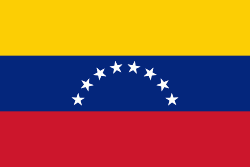El Hatillo Municipality (El Hatillo)
 |
 |
The seat of the municipal government is El Hatillo Town, founded in 1784 by Don Baltasar de León, who was instrumental in the area's development. Although the town had its origins during the Spanish colonisation, the municipality was not established until 1991. In 2000 – the year after a new constitution was enacted in Venezuela – some of the municipality functions were delegated to a consolidated mayor's office called Alcaldía Mayor, which also has some authority over the other four municipalities of Caracas.
El Hatillo has some of its colonial architecture, including an 18th-century parish church and a unique Romanian Orthodox Church. The municipality also has a rich artistic culture, with at least two important musical festivals celebrated yearly, and numerous holiday celebrations reflecting the heritage of El Hatillo. The culture, the pleasant temperature, the rural landscape, and the gastronomy of the municipality have made it a place of interest for visitors to the city, and a desirable place to live. The municipality receives a part of its income from tourism, an activity that is promoted by the government.
Although commercial areas are growing rapidly, agriculture remains a foundation of the economy in the rural areas of the southern part of El Hatillo. The business sector remains mostly underdeveloped, causing heavy employee movement in and out of the municipality – a problem that has made the transportation infrastructure of El Hatillo very congested.
In the 16th century, when the Spanish colonisation in the area began, El Hatillo was inhabited by the Mariches, an indigenous people possibly related to the Kalina (Caribs). Cacique Tamanaco was the leader of these tribes, known for resisting the Spanish colonisation. As the colonisation developed, the indigenous inhabitants were killed; by order of Caracas's founder Diego de Losada, Tamanaco was also murdered.
In 1752, Don Baltasar de León García arrived to El Hatillo from Cádiz, Spain, having just completed a prison term at La Carraca, Spain, for opposing (with his father) the monopoly rules of Guipuzcoana Company, which was in charge of maintaining exclusive trade between Spain and Venezuela. Don Baltasar founded El Hatillo Town, becoming one of the most significant contributors to its early development. Don Baltasar focused on making El Hatillo a strong, united and independent community, aiming to establish the area as a distinct parish from Baruta, on which El Hatillo depended. He accomplished this on June 12, 1784, when the governor and the bishop agreed to declare El Hatillo autonomous and under the direction of Don Baltasar, in front of 180 Canary-descendant families; this date is accepted as the foundation date of El Hatillo Town.
That same year, Don Baltasar and his brother-in-law donated their properties to the town, and an engineer assisted in the urban planning, which included grid streets and a parish church. The church was built to honor Santa Rosalía de Palermo, who Baltasar believed had saved him from a plague that killed his father in prison. In 1803, at the age of 79, Don Baltasar was unexpectedly killed in a horse accident.
In 1809, landlord and Lieutenant Colonel Manuel Escalona achieved the separation of El Hatillo from Petare, another suburb of Caracas, making it a different Tenientazgo de Justicia – a type of administrative division at the time. On April 19, 1810, Escalona enjoined the town to the movement of independence under Simón Bolívar, becoming another important person in the history of the municipality.
Ana Francisca Pérez García, Don Baltasar's wife, was a noteworthy woman in El Hatillo, attending to community children, elders and ill citizens. She donated a considerable amount of money for the construction of a hospital in Petare after the 1812 earthquake; this hospital is currently known as the Pérez de León de Petare Hospital.
One of the most ambitious urbanisation projects in El Hatillo since its founding was the neighborhood called La Lagunita. In the 1950s and 1960s, La Lagunita S.A. constructed a "functional, futuristic and comfortable" residential zone. To encourage people to settle in the area, each parcel included a membership to Lagunita Country Club, which was officially opened in 1964. Brazilian landscape designer Roberto Burle Marx contributed to this project, constructed on the 4.3 million m² hacienda that once belonged to former Venezuelan president, Eleazar López Contreras. La Lagunita has since become a wealthy neighborhood of El Hatillo.
Map - El Hatillo Municipality (El Hatillo)
Map
Country - Venezuela
Currency / Language
| ISO | Currency | Symbol | Significant figures |
|---|---|---|---|
| VES | Venezuelan bolÃvar | BsS. or Bs. | 2 |
| ISO | Language |
|---|---|
| ES | Spanish language |

















